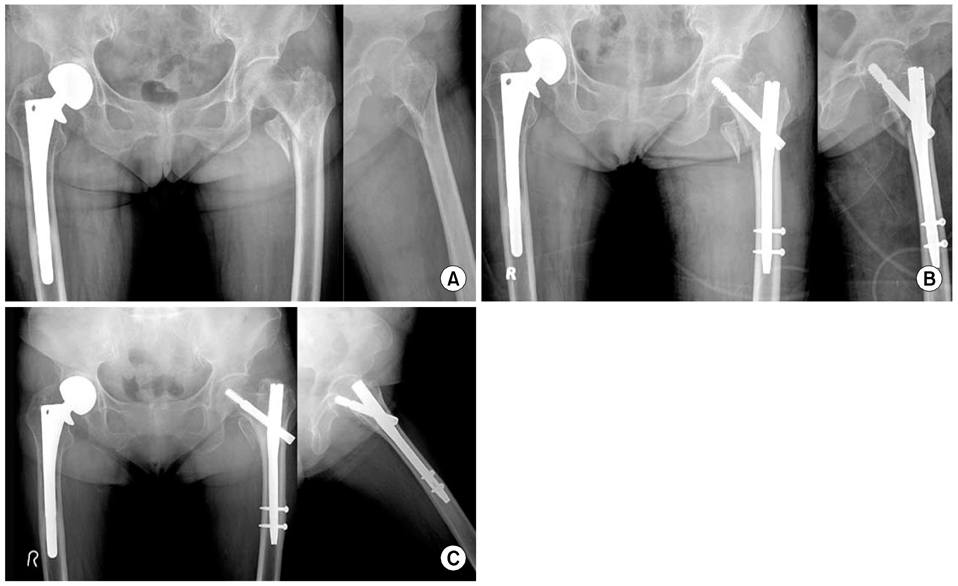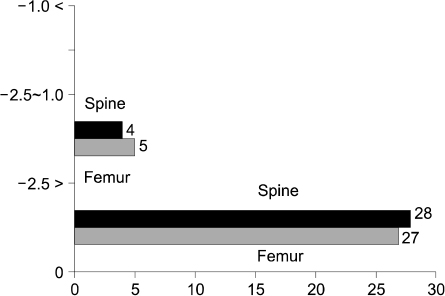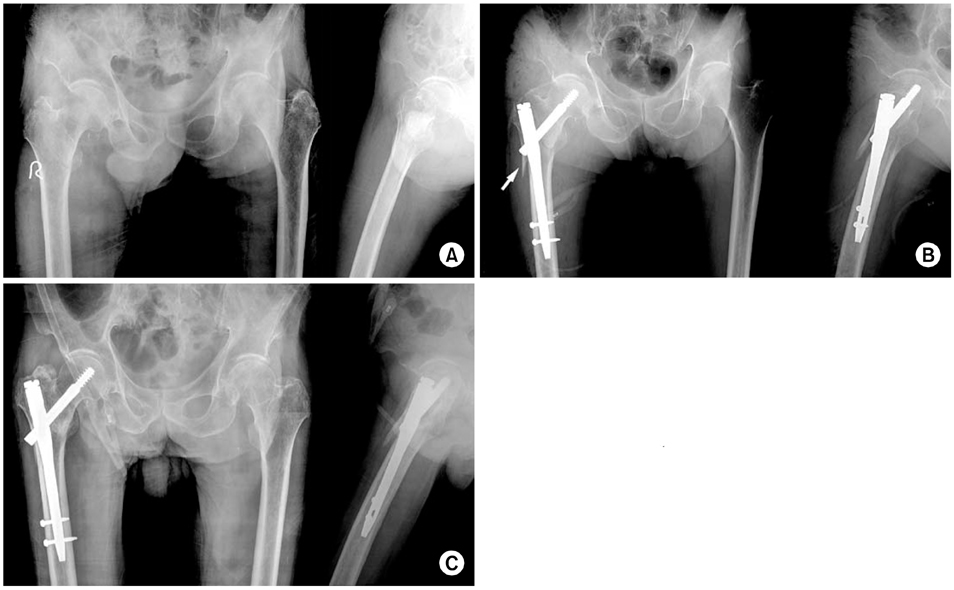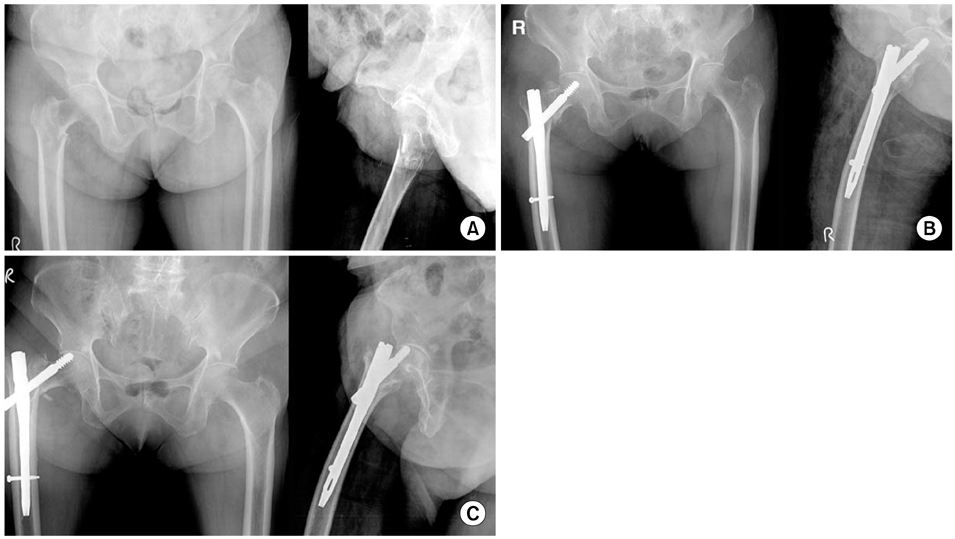Articles
- Page Path
- HOME > J Musculoskelet Trauma > Volume 20(3); 2007 > Article
-
Original Article
- Treatment of Senile Osteoporotic Intertrochanteric Fracture using Proximal Femoral Nail
- Dong-Hui Kim, M.D., Sang-Hong Lee, M.D., Young-Lae Moon, M.D., Jun-Young Lee, M.D., Kun-Sang Song, M.D.
-
Journal of the Korean Fracture Society 2007;20(3):215-221.
DOI: https://doi.org/10.12671/jkfs.2007.20.3.215
Published online: June 14, 2016
Department of Orthopaedic Surgery, College of Medicine, Chosun University, Gwangju, Korea.
- Address reprint requests to: Sang-Hong Lee, M.D. Department of Orthopaedic Surgery, Chosun University Hospital, 588, Seosuk-dong, Dong-gu, Gwangju 501-717, Korea. Tel: 82-62-220-3147, Fax: 82-62-226-3379, shalee@chosun.ac.kr
Copyright © The Korean Fracture Society. All rights reserved
- 589 Views
- 1 Download
- 2 Crossref
Abstract
-
Purpose
- Clinical and radiologic results of femur intertrochanteric fractures treated with ITST nail in elderly patients with osteoporosis were analysized to evaluate the efficacy and complication of ITST nailing.
-
Materials and Methods
- 32 patients who were treated with ITST nail due to femur intertrochanteric fracture and were followed up for more than 1 year were analysed. According to Evans classification, 11 cases were stable fractures and 21 cases were unstable fractures. Clinically, ambulatory function was compared and radiologically, BMD of healthy leg was checked with analysis of postoperative bone union and complication.
-
Results
- In ambulatory function comparison before and after the operation, there were 9 cases of good, 17 cases of moderate and 6 cases of poor. Considering social activity after the operation, 7 cases showed normal ambulation, 9 cases showed ambulatory with one cane, 5 cases showed two cane ambulation and 11 cases showed dependent ambulation. In radiologic evaluation, T-score of ward triangle in healthy femoral neck showed BMD of -3.12. In 20 cases, bone union was observed within 3 months. The patients with low BMD result had poor outcome. There were 2 cases of intraoperative proximal femur fracture, 3 cases of nonunion and 4 cases of death within 1 year.
-
Conclusion
- In elderly patients with intertrochanteric fracture, ITST nailing is relatively efficient treatment. However, in pateint with severe osteoporosis (T-score<-3.0) and unstable fracture pattern, arthroplasty should be considered due to relatively high complicaton rate.
- 1. Al-yassari G, Langstaff RJ, Jones JW, Al-Lami M. The AO/ASIF proximal femoral nail (PFN) for the treatment of unstable trochanteric femoral fracture. Injury, 2002;33:395-399.Article
- 2. Boldin C, Seibert FJ, Fankhauser F, Peicha G, Grechenig W, Szyszkowitz R. The proximal femoral nail (PFN)-a minimal invasive treatment of unstable proximal femoral fractures: a prospective study of 55 pateints with a follow-up of 15 months. Acta Orthop Scand, 2003;74:53-58.
- 3. Bridle SH, Patel AD, Bircher M, Calvert PT. Fixation of intertrochanteric fractures of the femur. A randomised prospective comparison of the gamma nail and the dynamic hip screw. J Bone Joint Surg Br, 1991;73:330-334.ArticlePDF
- 4. Chan KC, Gill GS. Cemented hemiarthroplasties for elderly patients with intertrochanteric fractures. Clin Orthop Relat Res, 2000;371:206-215.Article
- 5. Clawson DK. Trochanteric fractures treated by the sliding screw plate fixation method. J Trauma, 1964;27:737-752.
- 6. Domingo LJ, Cecilia D, Herrera A, Resines C. Trochanteric fractures treated with a proximal femoral nail. Int Orthop, 2001;25:298-301.
- 7. Evans EM. Trochanteric fractures; a review of 110 cases treated by nail-plate fixation. J Bone Joint Surg Br, 1951;33:192-204.
- 8. Green S, Moore T, Proano F. Bipolar prosthetic replacement for the management of unstable intertrochanteric hip fractures in the elderly. Clin Orthop Relat Res, 1987;224:169-177.
- 9. Han HJ, Yu HJ. The gamma nail for unstable peritrochanteric fractures. J Korean Soc Fract, 1996;9:76-80.
- 10. Hardy DC, Descamps PY, Krallis P, et al. Use of an intramedullary hip-screw compared with a compression hip-screw with a plate for intertrochanteric femoral fracutres. A prospective, randomized study of one hundred patients. J Bone Joint Surg Am, 1998;80:618-630.
- 11. Hwang DS, Kwak SK, Woo SM. Results of cementless hemiarthroplasty for elderly patients with unstable intertrochanteric fractures. J Korean Hip Soc, 2004;16:386-391.
- 12. Jensen JS, Michaelsen M. Trochanteric femoral fractures treated with McLaughlin osteosynthesis. Acta Orthop Scand, 1975;46:795-803.
- 13. Koval KJ, Zuckerman JD. Functional recovery after fracture of the hip. J Bone Joint Surg Am, 1994;76:751-758.
- 14. Kukla C, Pichl W, Prokesch R, et al. Femoral neck fracture after removal of the standard gamma interlocking nail: a cadaveric study to determine factors influencing the biomechanical properties of the proximal femur. J Biomech, 2001;34:1519-1526.
- 15. Kyle RF, Cabanela ME, Russell TA, et al. Fractures of the proximal part of the femur. Instr Course Lect, 1995;44:227-253.
- 16. Lorich DG, Geller DS, Nielson JH. Osteoporotic pertrochanteric hip fractures: management and current controversies. Instr Course Lect, 2004;53:441-454.
- 17. Min BW, Nam SY. Complications in patients with pertrochanteric fractures treated with a gamma Asia-Pacific locking nail. J Korean Orthop Assoc, 2001;36:429-435.
- 18. Orthopaedic Trauma Association Committee for Coding and Classification. Fracture and dislocation compendium. J Orthop Trauma, 1996;10:Suppl 1. v-ix. 1-154.
- 19. Parker MJ, Palmer CR. A new mobility score for predicting mortality after hip fracture. J Bone Joint Surg Br, 1993;75:797-798.
- 20. Rho KJ, Kim JO, Kim HH. Problems of compression hip screw for the treatment of intertrochanteric fracture in elderly patients. J Korean Soc Fract, 1999;12:502-508.
- 21. Rosenblum SF, Zuckerman JD, Kummer FJ, Tam BS. A biomechanical evaluation of the Gamma nail. J Bone Joint Surg Br, 1992;74:352-357.
- 22. Saudan M, Lubbeke A, Sadowski C, Riand N, Stern R, Hoffimeyer P. Pertrochanteric fractures: is there an advantage to an intramedullary nail?: a randomized, prospective study of 206 patients comparing the dynamic hip screw and proximal femoral nail. J Orthop Trauma, 2002;16:386-393.
- 23. Simmermacher RK, Bosch AM, Van der Werken C. The AO/ASIF-proximal femoral nail (PFN): a new dievice for the treatment of unstable proximal femoral fractures. Injury, 1999;30:327-332.
- 24. Sohn OJ, Kim SD, Kim IW, Byun SJ. A comparative study of trochanteric fractures treated with the intertrochanteric/subtrochanteric fixation or the proximal femoral nail. J Korean Fract Soc, 2006;19:303-308.
REFERENCES
Fig. 1

Distribution data of patient's BMD. Most of patients had osteoporosis with less than -2.5 of T-score in results of DEXA.

Fig. 2

Clinical results by Clawson's walking ability score. In comparison test of ambulatory function before and after the operation, there were 9 cases of good, 17 cases of moderate and 6 cases of poor postoperatively.

Fig. 3
(B) Postoperative radiographs show the fracture fixed with ITST nail.
(C) Follow-up radiographs 4 months after operation show bony union without any complications.

(A) Initial radiographs show a unstable intertrochanteric fracture from a slip down injury of a 71-year-old female patient. The T-score of BMD in this patient was -3.82.

Fig. 4
(B) Postoperative radiographs show proximal femur fracture during insertion of nail.
(C) Follow-up radiographs 6 months after operation show bony union without any complications.

(A) Initial radiographs show a stable intertrochanteric fracture from a slip down injury of a 84-year-old male patient. The T-score of BMD in this patient was -3.68.

Fig. 5
(B) Postoperative radiographs show the fracture fixed with ITST nail.
(C) Follow-up radiographs 2 months after operation show cutting out of lag screw into femoral head with loss of reduction due to fracture nonunion.

(A) Initial radiographs show an unstable intertrochanteric fracture from a slip down injury of a 83-year-old female patient. The T-score of BMD in this patient was -4.82.

Figure & Data
REFERENCES
Citations
Citations to this article as recorded by 

- The PFNA Nail for Pertrochanteric Fracture of the Femur without Fracture Table
Jeoung Ho Kim, Sang Hong Lee, Kwang Chul Lee, Sung Won Cho
Journal of the Korean Fracture Society.2011; 24(3): 217. CrossRef - Results of Osteoporotic Treatment Drug after Periarticular Fracture of Hip
Soo Jae Yim, Young Koo Lee, Cheong Kwan Kim, Hyun Seok Song, Hee Kyung Kang
Journal of the Korean Fracture Society.2010; 23(2): 167. CrossRef
Treatment of Senile Osteoporotic Intertrochanteric Fracture using Proximal Femoral Nail





Fig. 1
Distribution data of patient's BMD. Most of patients had osteoporosis with less than -2.5 of T-score in results of DEXA.
Fig. 2
Clinical results by Clawson's walking ability score. In comparison test of ambulatory function before and after the operation, there were 9 cases of good, 17 cases of moderate and 6 cases of poor postoperatively.
Fig. 3
(A) Initial radiographs show a unstable intertrochanteric fracture from a slip down injury of a 71-year-old female patient. The T-score of BMD in this patient was -3.82.
(B) Postoperative radiographs show the fracture fixed with ITST nail.
(C) Follow-up radiographs 4 months after operation show bony union without any complications.
Fig. 4
(A) Initial radiographs show a stable intertrochanteric fracture from a slip down injury of a 84-year-old male patient. The T-score of BMD in this patient was -3.68.
(B) Postoperative radiographs show proximal femur fracture during insertion of nail.
(C) Follow-up radiographs 6 months after operation show bony union without any complications.
Fig. 5
(A) Initial radiographs show an unstable intertrochanteric fracture from a slip down injury of a 83-year-old female patient. The T-score of BMD in this patient was -4.82.
(B) Postoperative radiographs show the fracture fixed with ITST nail.
(C) Follow-up radiographs 2 months after operation show cutting out of lag screw into femoral head with loss of reduction due to fracture nonunion.
Fig. 1
Fig. 2
Fig. 3
Fig. 4
Fig. 5
Treatment of Senile Osteoporotic Intertrochanteric Fracture using Proximal Femoral Nail

 E-submission
E-submission KOTA
KOTA TOTA
TOTA TOTS
TOTS
 Cite
Cite

